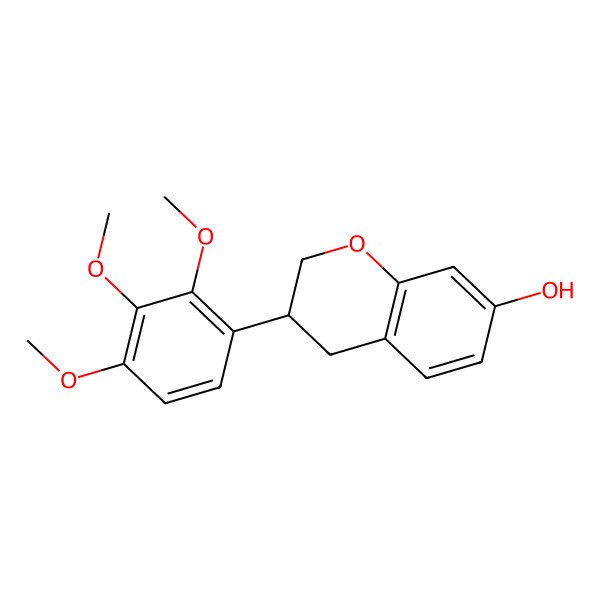(3R)-3-(2,3,4-trimethoxyphenyl)-3,4-dihydro-2H-chromen-7-ol
| Internal ID | 0581529e-598d-424e-9aa6-a3afdfe703fc |
| Taxonomy | Phenylpropanoids and polyketides > Isoflavonoids > O-methylated isoflavonoids > 4-O-methylated isoflavonoids |
| IUPAC Name | (3R)-3-(2,3,4-trimethoxyphenyl)-3,4-dihydro-2H-chromen-7-ol |
| SMILES (Canonical) | COC1=C(C(=C(C=C1)C2CC3=C(C=C(C=C3)O)OC2)OC)OC |
| SMILES (Isomeric) | COC1=C(C(=C(C=C1)[C@H]2CC3=C(C=C(C=C3)O)OC2)OC)OC |
| InChI | InChI=1S/C18H20O5/c1-20-15-7-6-14(17(21-2)18(15)22-3)12-8-11-4-5-13(19)9-16(11)23-10-12/h4-7,9,12,19H,8,10H2,1-3H3/t12-/m0/s1 |
| InChI Key | NAIULWLSYSLHJW-LBPRGKRZSA-N |
| Popularity | 0 references in papers |
| Molecular Formula | C18H20O5 |
| Molecular Weight | 316.30 g/mol |
| Exact Mass | 316.13107373 g/mol |
| Topological Polar Surface Area (TPSA) | 57.20 Ų |
| XlogP | 3.20 |
| DTXSID901170350 |
| (3R)-3,4-Dihydro-3-(2,3,4-trimethoxyphenyl)-2H-1-benzopyran-7-ol |

| Target | Value | Probability (raw) | Probability (%) |
|---|---|---|---|
| No predicted properties yet! | |||
Proven Targets:
| CHEMBL ID | UniProt ID | Name | Min activity | Assay type | Source |
|---|---|---|---|---|---|
| No proven targets yet! | |||||
Predicted Targets (via Super-PRED):
| CHEMBL ID | UniProt ID | Name | Probability | Model accuracy |
|---|---|---|---|---|
| CHEMBL3251 | P19838 | Nuclear factor NF-kappa-B p105 subunit | 96.64% | 96.09% |
| CHEMBL5619 | P27695 | DNA-(apurinic or apyrimidinic site) lyase | 95.36% | 91.11% |
| CHEMBL3060 | Q9Y345 | Glycine transporter 2 | 90.96% | 99.17% |
| CHEMBL1293249 | Q13887 | Kruppel-like factor 5 | 89.63% | 86.33% |
| CHEMBL5608 | Q16288 | NT-3 growth factor receptor | 89.30% | 95.89% |
| CHEMBL2535 | P11166 | Glucose transporter | 88.06% | 98.75% |
| CHEMBL4203 | Q9HAZ1 | Dual specificity protein kinase CLK4 | 86.26% | 94.45% |
| CHEMBL3108638 | O15164 | Transcription intermediary factor 1-alpha | 85.90% | 95.56% |
| CHEMBL1907603 | Q05586 | Glutamate NMDA receptor; GRIN1/GRIN2B | 85.36% | 95.89% |
| CHEMBL3137262 | O60341 | LSD1/CoREST complex | 85.06% | 97.09% |
| CHEMBL2581 | P07339 | Cathepsin D | 84.34% | 98.95% |
| CHEMBL225 | P28335 | Serotonin 2c (5-HT2c) receptor | 84.13% | 89.62% |
| CHEMBL4681 | P42330 | Aldo-keto-reductase family 1 member C3 | 83.89% | 89.05% |
| CHEMBL3359 | P21462 | Formyl peptide receptor 1 | 83.44% | 93.56% |
| CHEMBL5311 | P37023 | Serine/threonine-protein kinase receptor R3 | 82.77% | 82.67% |
| CHEMBL1994 | P08235 | Mineralocorticoid receptor | 81.60% | 100.00% |
| CHEMBL4478 | Q00975 | Voltage-gated N-type calcium channel alpha-1B subunit | 81.03% | 97.14% |
| CHEMBL5339 | Q5NUL3 | G-protein coupled receptor 120 | 80.79% | 95.78% |
| CHEMBL4306 | P22460 | Voltage-gated potassium channel subunit Kv1.5 | 80.74% | 94.03% |
| CHEMBL2335 | P42785 | Lysosomal Pro-X carboxypeptidase | 80.00% | 100.00% |
Below are displayed all the plants proven (via scientific papers) to contain this
compound!
To see more specific details click the taxa you are interested in.
To see more specific details click the taxa you are interested in.
| Astragalus pycnocephalus |
| PubChem | 15118760 |
| LOTUS | LTS0059303 |
| wikiData | Q105176340 |